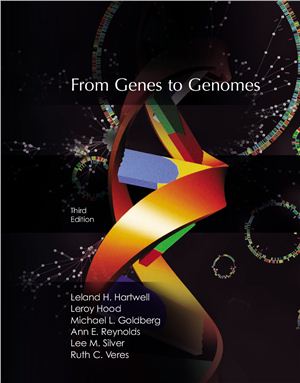3rd Edition, McGraw-Hill, 2008, 913 pages
"Genetics: From Genes to Genomes" is a cutting-edge, introductory genetics text authored by an unparalleled author team, including Nobel Prize winner, Leland Hartwell. The Third Edition continues to build upon the integration of Mendelian and molecular principles, providing students with the links between early genetics understanding and the new molecular discoveries that have changed the way the field of genetics is viewed.
This book represents a new approach to an undergraduate course in genetics. It reflects the way we, the authors, currently view the molecular basis of life. We integrate:
Formal genetics: the rules by which genes are transmitted.
Molecular genetics: the structure of DNA and how it directs the structure of proteins.
Genomics and systems biology: the new technologies that allow a comprehensive analysis of the entire gene set and its expression in an organism.
Human genetics: how genes contribute to health and disease.
The unity of life-forms: the synthesis of information from many different organisms into coherent models that explain many biological systems.
Molecular evolution: the molecular mechanisms by which biological systems and whole organisms have evolved and diverged.
The strength of this integrated approach is that students who complete the book will have a strong command of genetics as it is practiced today by academic and corporate researchers.
"Genetics: From Genes to Genomes" is a cutting-edge, introductory genetics text authored by an unparalleled author team, including Nobel Prize winner, Leland Hartwell. The Third Edition continues to build upon the integration of Mendelian and molecular principles, providing students with the links between early genetics understanding and the new molecular discoveries that have changed the way the field of genetics is viewed.
This book represents a new approach to an undergraduate course in genetics. It reflects the way we, the authors, currently view the molecular basis of life. We integrate:
Formal genetics: the rules by which genes are transmitted.
Molecular genetics: the structure of DNA and how it directs the structure of proteins.
Genomics and systems biology: the new technologies that allow a comprehensive analysis of the entire gene set and its expression in an organism.
Human genetics: how genes contribute to health and disease.
The unity of life-forms: the synthesis of information from many different organisms into coherent models that explain many biological systems.
Molecular evolution: the molecular mechanisms by which biological systems and whole organisms have evolved and diverged.
The strength of this integrated approach is that students who complete the book will have a strong command of genetics as it is practiced today by academic and corporate researchers.

